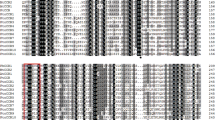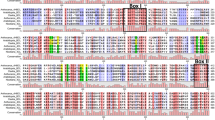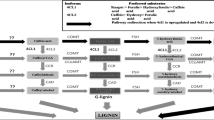Abstract
A cinnamoyl coenzyme A reductase (CCR, EC 1.2.1.44), one of the key enzyme involved in lignin biosynthesis, was cloned from Populus tomentosa (Chinese white poplar). At the same time, a 4CL1 gene was cloned from P. tomentosa, too. The two genes were subcloned in pQE31 vector and expressed in Escherichia coli M15. Both of them were purified by Ni-NTA. Purified CCR protein was digested by trypsin and analyzed by HPLC-MS; the peptide segments had 27% similarity with the sequence of the CCR protein. 4CL was thought to be a neighbor enzyme of CCR in lignin biosynthesis. In this paper, a 4CL1 from P. tomentosa was cloned, and its enzyme reaction products were extracted for the substrates of CCR. Three 4CL1 enzyme reaction products were monitored by HPLC-MS and then the CCR enzyme reaction was detected by GC-MS. In the CCR reaction, the three corresponding aldehyde (p-coumaraldehyde, caffealdehyde, and coniferaldehyde) were detected and identified by Frontier3 software. The results showed that the CCR that we cloned from P. tomentosa had affinities with 4CL1 enzyme reaction products and a ptCCR that was cloned from aspen (Li et al., Plant Cell Physiol 46(7):1073–1082, 2005) only had affinity with feruloyl-CoA. The different results maybe depend on the different study method. The method of exacting 4CL enzyme products as the substrates of CCR in the paper was reliable and can be used in lignin biosynthesis network to detect the enzymes in the neighborhood that depended on the polarity of the substrates and products. This CCR gene had eight homology sequence CCR gene when a BLAST was conducted in Populus trichocarpa genome database. The CCR homology genes in Populus suggested that some CCRs may take part in the lignin biosynthesis, too. The gene family would be the hot spot in the future study.









Similar content being viewed by others
References
Baltas M, Lapeyre C et al (2005) Kinetic and inhibition studies of cinnamoyl-CoA reductase 1 from Arabidopsis thaliana. Plant Physiol Biochem 43(8):746–753
Barriere Y, Ralph J et al (2004) Genetic and molecular basis of grass cell wall biosynthesis and degradability. II. Lessons from brown-midrib mutants. C R Biol 327(9–10):847–860
Besseau S, Hoffmann L et al (2007) Flavonoid accumulation in Arabidopsis repressed in lignin synthesis affects auxin transport and plant growth. Plant Cell 19(1):148–162
Freudenberg K (1959) Biosynthesis and constitution of lignin. Nature 183(4669):1152–1155
Goffner D, Van Doorsselaere J et al (1998) A novel aromatic alcohol dehydrogenase in higher plants: molecular cloning and expression. Plant Mol Biol 36(5):755–765
Gross GG, Kreiten W (1975) Reduction of coenzyme A thioesters of cinnamic acids with an enzyme preparation from lignifying tissue of Forsythia. FEBS Lett 54(2):259–262
Fan B-Y, Hu S-Y, Lu H, Jiang X-N (2006) Soluble prokaryotic expression of 4-coumarate:coenzyme A ligase from Populus tomentosa and enzyme activity of recombinant 4CL1. Journal of Beijing Forestry University 28(2):1–8
Hu WJ, Kawaoka A et al (1998) Compartmentalized expression of two structurally and functionally distinct 4-coumarate: CoA ligase genes in aspen (Populus tremuloides). Proc Natl Acad Sci U S A 95(9):5407–5412
Huntley SK, Ellis D et al (2003) Significant increases in pulping efficiency in C4H–F5H-transformed poplars: improved chemical savings and reduced environmental toxins. J Agric Food Chem 51(21):6178–6183
Inoue K, Sewalt VJ et al (1998) Developmental expression and substrate specificities of alfalfa caffeic acid 3-O-methyltransferase and caffeoyl coenzyme A 3-O-methyltransferase in relation to lignification. Plant Physiol 117(3):761–770
Jones L, Ennos AR et al (2001) Cloning and characterization of irregular xylem4 (irx4): a severely lignin-deficient mutant of Arabidopsis. Plant J 26(2):205–216
Kawasaki T, Koita H et al (2006) Cinnamoyl-CoA reductase, a key enzyme in lignin biosynthesis, is an effector of small GTPase Rac in defense signaling in rice. Proc Natl Acad Sci U S A 103(1):230–235
Lee D, Meyer K et al (1997) Antisense suppression of 4-coumarate:coenzyme A ligase activity in Arabidopsis leads to altered lignin subunit composition. Plant Cell 9(11):1985–1998
Li L, Cheng X et al (2005) Clarification of cinnamoyl co-enzyme A reductase catalysis in monolignol biosynthesis of Aspen. Plant Cell Physiol 46(7):1073–1082
Ma QH (2007) Characterization of a cinnamoyl-CoA reductase that is associated with stem development in wheat. J Exp Bot 58(8):2011–2021
Ruegger M, Chapple C (2001) Mutations that reduce sinapoylmalate accumulation in Arabidopsis thaliana define loci with diverse roles in phenylpropanoid metabolism. Genetics 159(4):1741–1749
Wang G et al (2002) Principle and technology of plant gene engineering. (M)
Acknowledgement
The work is jointly supported by the 973 Project (G1999016005) and Natural National Science Foundation of China (NSF 30630053) granted to Professor Dr. Xiangning JIANG.
Author information
Authors and Affiliations
Corresponding author
Rights and permissions
About this article
Cite this article
Wang, DD., Bai, H., Chen, WQ. et al. Identifying a Cinnamoyl Coenzyme A Reductase (CCR) Activity with 4-Coumaric Acid: Coenzyme A Ligase (4CL) Reaction Products in Populus tomentosa . J. Plant Biol. 52, 482–491 (2009). https://doi.org/10.1007/s12374-009-9062-6
Received:
Revised:
Accepted:
Published:
Issue Date:
DOI: https://doi.org/10.1007/s12374-009-9062-6




